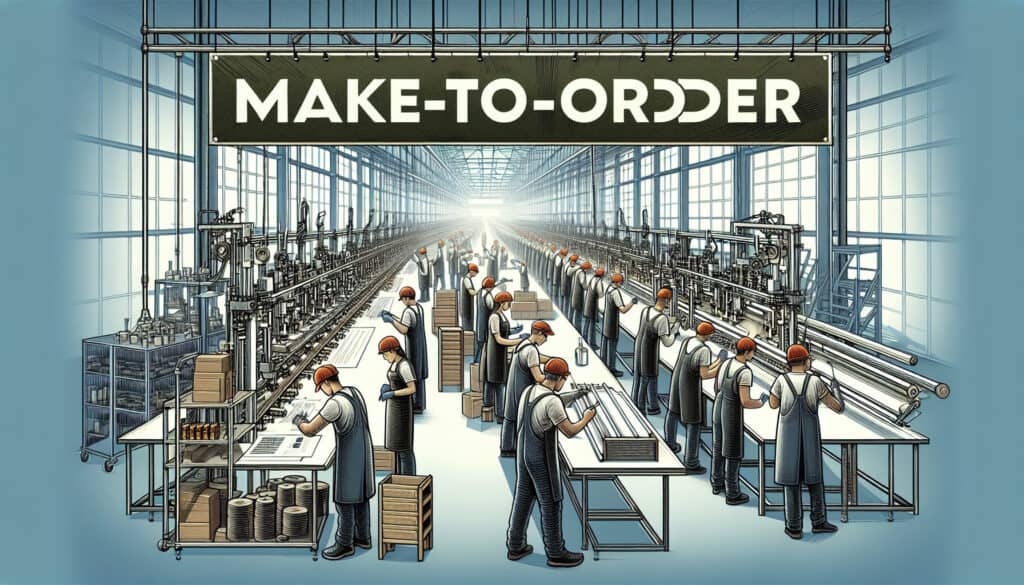To produce a product only after a customer has placed an order.
- Metodologie: Ergonomia
Make-to-Order (MTO)

Make-to-Order (MTO)
- Fabbricazione additiva, Just-in-Time (JIT), Produzione snella, Progettazione del prodotto, Sviluppo del prodotto, Catena di approvvigionamento, Pratiche di sostenibilità, Proposta di valore
Obiettivo:
Come si usa:
- A manufacturing strategy where production is initiated only after a confirmed customer order is received. This allows for a high degree of customization and reduces the risk of unsold inventory.
Professionisti
- Allows for a high degree of customization; Reduces the risk of obsolescence and excess inventory.
Contro
- Longer lead times for customers; Can be difficult to manage fluctuating demand.
Categorie:
- Lean Sigma, Produzione
Ideale per:
- Producing customized products such as high-end furniture, specialized machinery, or tailored clothing.
Make-to-Order (MTO) methodology is particularly effective in industries where customer preferences vary significantly and where the demand for unique products is strong, such as aerospace, automotive, custom machinery, and fashion design. This strategy can be implemented during various project phases, from design and prototyping to production and delivery. It necessitates close collaboration between designers, engineers, and clients to ensure that specifications are fully understood and met. MTO projects often involve the use of sophisticated customer relationship management tools and flexible manufacturing systems to adapt quickly to changing requirements, ensuring that products not only meet high standards but also align with clients’ evolving needs. Participants usually include sales teams who work directly with customers, design engineers who translate requests into specifications, and production teams skilled in handling custom builds. In applications like medical devices, where each product may need to conform to specific regulatory requirements, MTO provides a pathway to compliance while serving customer-specific demands. The iterative nature of the MTO process can also drive innovation, as customer feedback from early orders can inform the development of new products and improvements to existing lines, thus promoting a culture of continuous enhancement.
Fasi chiave di questa metodologia
- Receive confirmed customer order with product specifications.
- Review design requirements and feasibility of customization.
- Initiate production planning and resource allocation.
- Design prototypes or mock-ups as needed for approval.
- Commence manufacturing once designs are approved.
- Monitor production progress and quality control throughout.
- Make adjustments based on feedback or changes in specifications.
- Finalize product and prepare for delivery to the customer.
Suggerimenti per i professionisti
- Implement advanced analytics for accurate demand forecasting, allowing for better resource allocation and scheduling.
- Enhance communication between sales and production teams to ensure alignment on customization options and production feasibility.
- Invest in modular design principles to facilitate efficient customization while minimizing lead times and production costs.
Leggere e confrontare diverse metodologie, raccomandiamo il
> Ampio archivio di metodologie <
insieme ad altre 400 metodologie.
I vostri commenti su questa metodologia o ulteriori informazioni sono benvenuti su sezione commenti qui sotto ↓ , così come tutte le idee o i link relativi all'ingegneria.
Contesto storico
1949
1950
1950
1960
1960
1960
1960
1940
1950
1950
1958
1960
1960
1960
1960
(se la data non è nota o non è rilevante, ad esempio "meccanica dei fluidi", viene fornita una stima approssimativa della sua notevole comparsa)















Post correlati
Programma di produzione principale (MPS)
Personalizzazione di massa
Imbuto di marketing
Audit di marketing
Indice MAPO (Movimento e assistenza dei pazienti in ospedale)
Pianificazione delle risorse di produzione (MRP II)